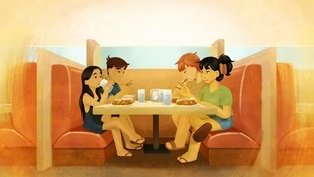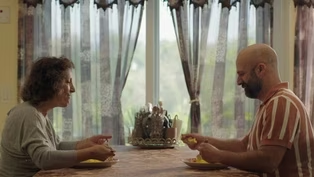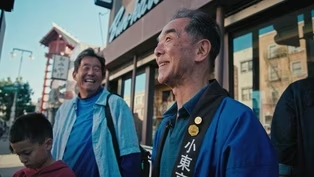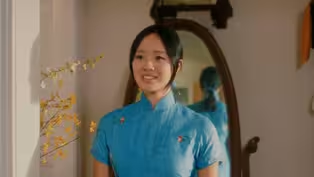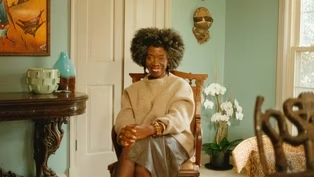
Voices of Little Tokyo
Clip: Season 26 Episode 2 | 14m 57sVideo has Closed Captions
Little Tokyo residents voice concerns with a mega development proposal. (Nana Nakano/Chapman)
Little Tokyo is one of the eleven most endangered historical places in the United States. When a mega development project is proposed to be built right outside of the community, four elderly community leaders- a tour guide, an activist, a resident, and a small business owner- voice their concerns. (Nana Nakano/Chapman)
Problems playing video? | Closed Captioning Feedback
Problems playing video? | Closed Captioning Feedback
Fine Cut is a local public television program presented by PBS SoCal

Voices of Little Tokyo
Clip: Season 26 Episode 2 | 14m 57sVideo has Closed Captions
Little Tokyo is one of the eleven most endangered historical places in the United States. When a mega development project is proposed to be built right outside of the community, four elderly community leaders- a tour guide, an activist, a resident, and a small business owner- voice their concerns. (Nana Nakano/Chapman)
Problems playing video? | Closed Captioning Feedback
How to Watch Fine Cut
Fine Cut is available to stream on pbs.org and the free PBS App, available on iPhone, Apple TV, Android TV, Android smartphones, Amazon Fire TV, Amazon Fire Tablet, Roku, Samsung Smart TV, and Vizio.
Providing Support for PBS.org
Learn Moreabout PBS online sponsorshipLittle Tokyo, to me, in one word, would be vibrant.
You want to be here.
It's the place to be.
My mother worked in a sewing factory, so as a child, I used to take the bus all by myself and meet her here in Little Tokyo.
It was a time where I could get a snow cone, Japanese noodles, and of course, my favorite, rice paper candy.
When I was going to USC, I started working part-time at a small bank, and I recall walking around the neighborhood.
I became more intrigued about these, especially older parts of Little Tokyo.
I had a lot of fun going down there for Nisei Week.
What I liked was the Nisei Week car contest because everybody, all the teenage kids and stuff, they used to all soup up their cars and bring it out there.
They used to see all these '65 GTOs, all these muscle cars.
The very first project I did was at Casa Heiwa, and it has a fan at the entryway.
I had metal pieces that had silk-screen photographs of people in the community.
All of the photos, all these kids nowadays are all grown up and have their own children.
It's fun to look at now.
[music] Welcome to Little Tokyo.
Right where Central Avenue butts up against First Street, you get a very good vantage point of Little Tokyo's past with the former Nishi Hongwanji Buddhist Temple.
Little Tokyo, to me, represents historic continuity because Little Tokyo this year is celebrating its 140th anniversary.
People have mentioned that I'm a fixture here.
With me being involved in Little Tokyo so much, I am a continuum of my grandparents being here in the 1920s.
When I walk the streets of Little Tokyo giving tours, it feels I'm literally walking in their footsteps.
At this site in 1884, Hamanosuke Sugita, who was a sailor, and he jumped overboard on the ship he was on, opened Kame Restaurant, the first Japanese-owned business in Los Angeles, sparking the beginning of Little Tokyo.
First few decades of the early 20th century, more migration occurred from Japan to Los Angeles.
Little Tokyo was becoming more developed.
It was a community, a living community, a thriving community in the 1920s and 1930s.
[music] In May of 2024, Little Tokyo was recognized as one of the 11 most endangered sites in the United States.
Urban renewal, gentrification, COVID, online shopping, all of these have contributed to the shrinking of the Little Tokyo community.
We are not your chorus trap, Little Tokyo's fighting back.
What they're fighting against is the $2 billion mega development that's proposed to be built at Fourth and Central on the southernmost section of Little Tokyo.
He claims there's going to be lots of jobs, but what we see is a 44-story monstrosity facing us on the south end of Little Tokyo.
It's going to change Little Tokyo forever.
In my entire life, I never thought I'd be an activist.
As a small child, I resented being an immigrant.
I resented being Japanese.
The years of being made fun of for being an FOB, the years of being told that rice balls look ridiculous, all that stuff leads to anger and resentment.
Those things are the ones that lead to activism in my case.
You pick the wrong people, do?
The Fourth and Central project.
It's just another part of the 50, 60-year struggle to keep Little Tokyo alive.
November 20th is the final hearing for the environmental impact report.
If this environmental impact report is approved, they're going to go on and build it.
Are we ready to get started, everyone?
Good morning, everyone.
This is the scheduled public hearing for the Fourth and Central project, as well as the planning entitlement requests for this hearing.
Before we begin [?]
itself,- -I'm going to put it up like this.
I'm going to put it up like this.
I will be giving some general instructions.
Then go like this.
Good morning, everyone.
My name is Edward Kian, and I'm a partner at the Mayer Brown Law Firm.
I'm here today on behalf of the applicant, CPLA Cold Storage Land.
The project proposes to replace the existing industrial uses on the project site with an exciting mixed-use development that will infuse the area with a dynamic mix of residential, office, retail, and restaurant uses.
[music] I've been in and around Little Tokyo for so long.
There's lots of stories.
Right now, I'm in the community and doing my art.
I did a lot of collage paintings using Japanese papers.
This is probably one that I did in the '90s.
This building is Tokyo Villa.
It's the first condominium project that was built in Little Tokyo.
Nowadays, with the prices of rents and the housing crisis, it's really difficult to get some kind of unit like this.
I think they're going to build a new development at the cold storage space, which is just a block away from here.
If you don't live here, and if you don't know the communities, you think, "Wow, that's a really great thing.
That's a good place to put that project."
Taking into consideration the people that are living here now, can they afford to stay in the neighborhood?
Taking into consideration the people that are living here now, can they afford to stay in the neighborhood?
The rents will definitely go up, and it's such a shame because they just go in and then they just bulldoze their way through and don't think about the people that are actually living there.
I was a senior in high school, so I had started Rafu Bussan one year prior to this because I graduated Roosevelt in 1974.
Rafu Bussan, after the Kawaratani's took over in 1958, has been in business for 64 years.
The first time we moved, we had no choice.
It was eminent domain.
They were going to get rid of some of the stores on historic First Street and create the now Japanese Village Plaza.
I'm very aware of-- we have the cold storage project.
Our main concern is how are they going to connect with our community, with Little Tokyo?
Part of gentrification is only these big companies can afford the rising rent.
It's a huge concern for me.
The Daruma, traditionally a papier-mache product with the red, the white, the black, and then the gold leaf accent.
Our biggest importer gave it to us to wish us to rise.
The Japanese.
saying for the Daruma is nana korobi yaoki, which means seven times fall, each time you rise, and on the eighth occasion, you stay up.
I take it as humankind perseveres against all hardship, and you rise.
Bonsai's a pain in the ass.
Each bonsai tree might be a couple hundred years, so during their lifetime, they get transferred to different owners.
This one's about 75 years when I got it.
I got another 20 years left, so I got to give it to somebody else so they'll take care of it.
Sounds like what you're doing with Little Tokyo.
[chuckles] I just hope someone takes it up, that's all.
In your mind, I'm going to ask you to visualize the Little Tokyo parcel in 1938, 1940.
In 1953, Parker Center, the cop station, they wanted one-fourth of Little Tokyo for that.
Through eminent domain by the city of L.A., the city took over the entire quadrant.
The Japanese community, they did not want to fight City Hall because they had just returned to Little Tokyo from leaving the concentration camps.
Once you left the camps, you were vulnerable to everyone, to American society who did not want you.
My family, both of my parents being incarcerated in the concentration camps, all that psychological trauma that my parents and their parents and all the families went through, it got passed down to the next generation.
Hi, my name is David Monk.
I am chairperson of Little Tokyo Against Gentrification.
We oppose this horrific project as is because it does not provide enough housing, it does not address the key issues that affect our community.
Look at the way Little Tokyo is from our point of view.
In 1942, with the concentration camps, 90% of Little Tokyo got amputated.
In 1953, with the police station, another quarter of Little Tokyo, what remained, was taken away.
During the 1970s, hundreds of working-class people were evicted to make way for a luxury hotel.
Now, this development that Mark Falcone is bringing will finally slice up the rest of Little Tokyo.
My family and I are concerned about the present and future status of Little Tokyo.
We support maintaining the community culture of Little Tokyo and oppose gentrification that drastically changes that culture so that Little Tokyo does not become a hollow shell of itself for the sake of profit.
Just in the last couple of years since the new metro station, we've already lost over 50 small businesses due to rising rents.
We've been here for over 140 years despite a history of systemic racism and displacement, and we have a vision for the future.
I invite you to read it.
I just want to point to the voices that are here with me.
The people who are speaking in opposition to this project, they aren't here because they stand to gain jobs or profit or foot traffic.
They're here because they love this neighborhood.
There are people who have shepherded this neighborhood through decades of encroachment.
When they tell us to be worried, we get worried because they've seen Little Tokyo through all of these years, and they know what it takes to keep the community alive.
[music]
Video has Closed Captions
Clip: S26 Ep2 | 5m 3s | Flowing water and memories, the mind's journey to find home. (Kai Ho/California College of the Arts) (5m 3s)
Video has Closed Captions
Clip: S26 Ep2 | 10m 9s | An Iranian-American recounts his relationship with the language he forgot. (Omid Iranikhah/Chapman) (10m 9s)
Preview: S26 Ep2 | 30s | Five short films from California students at Chapman, LMU & California College of the Arts. (30s)
Video has Closed Captions
Clip: S26 Ep2 | 10m 58s | A Chinese American teen in 1960s California struggles to fit in at a party, (Xiaoxi Qin/LMU) (10m 58s)
Video has Closed Captions
Clip: S26 Ep2 | 14m 51s | A scrapbook documents experiences with colorism. (Zola Franchi, Vivienne Ayres, Nidhi Kumar/Chapman) (14m 51s)
Providing Support for PBS.org
Learn Moreabout PBS online sponsorship

- Arts and Music

Innovative musicians from every genre perform live in the longest-running music series.












Support for PBS provided by:
Fine Cut is a local public television program presented by PBS SoCal
